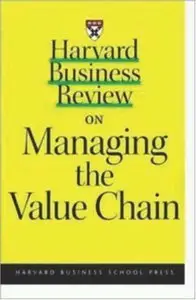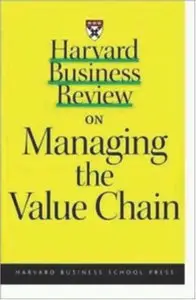Carliss Baldwin, Kim B. Clark, Joan Magretta, Jeffrey H. Dyer, Marshall Fisher, Donald V. Fites, "Harvard Business Review on Managing the Value Chain"
English | ISBN: 1578512344 | 2000 | EPUB, PDF | 288 pages | 3 MB
English | ISBN: 1578512344 | 2000 | EPUB, PDF | 288 pages | 3 MB
Leading Minds and Landmark Ideas In An Easily Accessible Format From the preeminent thinkers whose work has defined an entire field to the rising stars who will redefine the way we think about business, The Harvard Business Review Paperback Series delivers the fundamental information today's professionals need to stay competitive in a fast-moving world. As technology and globalization have disrupted traditional operations along the supply chain, the relationship between suppliers, customers, and competitors has changed dramatically. Examining this issue from several strategic perspectives, Harvard Business Review on Managing the Value Chain outlines key ideas and provides guidance for incorporating shifts in the value chain into your strategic outlook. A Harvard Business Review Paperback.
Summary: How to avoid or eliminate a "weak link"
Rating: 5
This is one in a series of several dozen volumes that comprise the Harvard Business Review Paperback Series. Each offers direct, convenient, and inexpensive access to the best thinking ("ideas with impact") about the given subject in articles originally published by the Harvard Business School Review. I strongly recommend all of the volumes in the series. The individual titles are listed at this Web site: www.hbsp.harvard.edu. The authors of various articles are among the world's most highly regarded experts on the given subject. Each volume has been carefully edited. Supplementary commentaries are also provided in most of the volumes, as is an "About the Contributors" section that usually includes suggestions of other sources that some readers may wish to explore.
In this volume, the reader is provided with eight articles whose authors provide a variety of perspectives on managing the value chain. Given when they first appeared in the HBR (1993-1998), some but remarkably little of the material is dated. Here are brief excerpts from the Executive Summaries of two articles:
"As businesses as diverse as auto manufacturing and financial services move toward modular designs, the authors say, competitive dynamics will change enormously. No longer will assemblers control the final product: suppliers of key modules will gain leverage and even take on responsibility for design rules. Companies will compete either by specifying the dominant design rules (as Microsoft does) or by producing excellent modules (as does disk drive maker Quantum does)." Managing in an Age of Modularity," Carliss Y. Baldwin and Kim B. Clark
"In today's fast-changing competitive environment, strategy is no longer a matter of positioning a fixed set of activities along that old industrial model, the value chain. Successful companies increasingly do not just add [begin italics] value [end italics], they [begin italics] reinvent [end italics], it. The key strategic task is to reconfigure roles and relationships among a constellation of actors - su0pplers, partners, customers - in order to mobilize the creation of value by new combinations of players." From Value Chain to Value Constellations: Designing Interactive Strategy, Richard Normann and Rafael Ramirez
I also want to include a brief portion of Joan Magretta's interview of Victor Fung. He later develops many of his thoughts in greater depth in a book, Competing in a Flat World, co-authored with Yoram (Jerry) Wind. Fung is Group Chairman of Li & Fung, Hong Kong's largest export trading company.
Magretta: "Can you give me an example of how you reach into the supply chain to shorten the buying cycle?"
Fung: "We come in and look at the whole supply chain. We know the Limited is going to order 100,000 garments, but we don't know the style or colors yet. The buyer will tell us that five weeks before delivery. The trust between us and our supply network means that we can reserve undyed yarn from the yarn supplier. I can lock up capacity at the mills for the weaving and dying with the promise that they'll get an order of a specified size; five weeks before delivery, we will let them know what colors we want. Then I say the same thing to the factories. `I don't know the product specs yet, but I have organized the colors and the fabric and the trim for you, and they'll be delivered to you on this date and you'll have three weeks to produce so many garments.'…It's all about flexibility, response time, small production runs, small minimum-order quantities, and the ability to shift direction as the trends move."
These brief excerpts are representative of the thrust and flavor of all of the material provided in this volume. Of course, before managing a value chain, it is first necessary to design and then establish one that is most appropriate to the given organization. For cutting-edge thinking on that, I highly recommend Enterprise Architecture as Strategy: Creating a Foundation for Business Execution by Jeanne W. Ross, Peter Weill, and David Robertson as well as Dean R. Spitzer's Transforming Performance Measurement: Rethinking the Way We Measure And Drive Organizational Success and Richard Ogle's Smart World: Breakthrough Creativity and the New Science of Ideas.



